| |
| |
MadonnaTribe had the chance to meet the
creative team at STEELE, for a great chat
on the post production work on "Future Lovers",
the opening video sequence of Madonna's latest live show,
the Confessions Tour. Dim the lights, sit
back and enjoy this interesting interview.
MTribe: Hi Monique, Jerry and Brian and
welcome to MadonnaTribe.com
Sometimes it happens that the name of an artist comes into
the public's eye for a recent work, while the same artist
has been hard working with the best clients in the industry
for years.
The name of STEELE has become popular among Madonna fans
for your work on the opening act of her "Confessions
Tour", but this wasn't the first time you worked for
her, right?
|
|
|
Jerry: Right, I first worked on a music
video called "I'll Remember". It was a beautiful
piece where we really developed and finessed our trademark
style for beauty and finishing.
MTribe: Let's talk about the "Paradise
(Not For Me)" video interlude for Madonna's Drowned
World Tour.
Was that one your first work to be featured on a Madonna
live show?
Jerry: Yeah.
MTribe: The video was directed by Dago
Gonzàlez at Veneno, Inc and has a subtle and not
easy to get storyline filled by haunting images and an
amazing visual strength.
What was STEELE's contribution to this video?
Jerry: Firstly, I would like to say
that we were extremely happy to once again have the opportunity
to offer our talents to the incredible Madonna.
STEELE was responsible for the Digital Online, Visual
Effects and Compositing, various beauty requirements and
multiple format deliverables.
MTribe: Having a look at your studio
reel I was impressed by how products that are so different
- music videos, commercials, tv interludes and so on -
have all a particular feel. Do you think there's some
sort of "trademark" STEELE quality that we can
find in your works?
Jerry: Creatively, we offer a gamut of
styles, from photoreal CG character animation to green
screen compositing, each of which is tailored to the specific
job at hand. Over the years, however, we have developed
a reputation for adding the final gloss to all the imagery
that comes out of our facility. Part of that stems from
our ability to make sure all of our music video client-artists
look as beautiful as they can be and that products in
our spots, such as cars, have that sizzle factor.
|
|
| |
MTribe:
Do you remember when were you contacted for working on the
Confessions Tour?
Brian: That was a couple months before
the tour kicked off.
MTribe: Time schedules
may be tight when it comes to working for Madonna. How did
it go this time for you? How were you asked to work on "Future
Lovers" and did you have some time left to sleep at
night?
Brian: There definitely were some
sleepless nights, as we were essentially putting together
multiple videos for the same song - one for each screen
with different edits in each.
|
|
 |
| |
MTribe:
The entire opening sequence of the Confessions Tour is really
unique.
"Future Lovers" is not simply a video, but an
elaborate performance that starts from the main screen -
moves to the smaller stage where the disco ball lands and
Madonna performs the most of the song before eventually
getting back to the main stage.
Were you aware of how the action was going to take place
on the live stage while you were working on the video?
Brian: Yes, we were very involved in how
everything integrated from the beginning. Before we even
started our part, I was given an animatic, or a rough 3D
rendering, of how the arena and sets and screens would be
placed in relation to one another in the arena. This was
important for us to visualize where and how our video would
play within the show. Then I went to the arena as the sets
were being built and during rehearsals in order to get a
more visceral feel of the show in a live format.
|
|
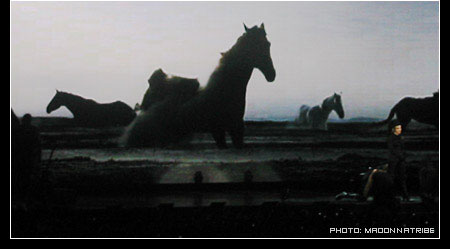  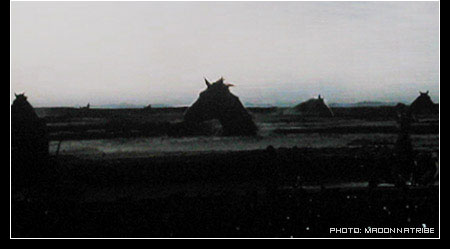 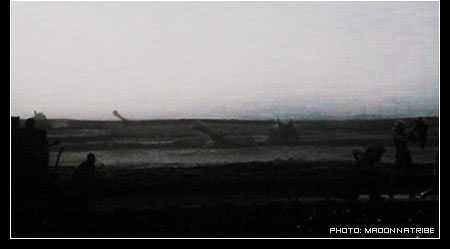
|
MTribe: I noticed
that the lighting designers worked in a brilliant way,
successfully driving the crowd's attention from the back
to the front of the scene. Has anything in the video projection
been set up in a similar way, meaning that the images
have a different "quality" when Madonna appears
from inside the mirror ball?
Brian: The image "quality" and style
do not change. We did, however, have to do a bunch of
testing during rehearsals to make sure that the brightness
levels of the video worked with the lighting design in
the arena, all of which is automated for specific musical
cues. Everything in Clark Eddy's brilliant cut was designed
to time exactly with all of the stage action. We met with
Jaime King, the show's director, early on at the Forum
in L.A. to make sure the video played in sync with the
action, so that the spectators would be taken on a specific
journey.
The cool thing about Future Lovers is that as the opening
act, it's the only video of the entire show that plays
on it's own, even before Madonna appears. So the audience
is fixated on the images, which really builds anticipation
in the arena, before the disco ball's descent and Madonna's
appearance.
MTribe: Monique, you were the lead artist for
the "Future Lovers" video and created and composited
the sequences in which horses rise from the Earth and
descend into the ground at the end.
I understand this was quite challenging and there's a
lot of work from the original footage to the final result
we saw on the screens. Can you tell us a bit more about
it?
Monique: Each horse was filmed individually
in slightly different environments. So, each horse had
to be cut out from its original background and composited
into the final scene, which was originally completely
absent of horses and dust. As the horses emerge from or
descend into the earth it was important to maintain the
dust and dirt from their original surroundings and incorporate
it into the new environment. Then the blowing dust from
another scene was blended into the final composites to
add to the mystery of the appearance or disappearance
of the horses.
MTribe: How was the original footage by
Steven Klein prepared and transformed for the larger scale?
Monique: The
original footage was transferred 720x486 pixels, a typically
shaped 4 x 3 aspect ratio frame. I then cropped each stream
- there was one for every screen in the arena - to the
particular aspect ratio of that screen, some of which
were very unconventional in shape. All of the screens
were then composited back into one 1920 x 1080 frame with
a matte over the top, creating a collage, which the playback
personnel decode and thereby send each stream to a separate
screen. Because all the streams start out on the same
screen on our end, this is why they can't be off by even
a pixel, or the wrong information will be sent to the
individual screens in the arena, where a pixel could be
a foot in size.
MTribe: And
how was working with Steven Klein on this project? Did
you have to work on different cuts of the video or your
job was more straight forward?
|
|
| |
Brian:
Working with Steven was great. He's an accomplished
photographer, and he gave us stills to reference to how
he wanted the color grading and certain framing requirements.
For the horse descent, he gave us a still composite of how
he wanted the layout to look. As far as the cuts go, there
were constant revisions everyday, so Clark, the editor,
would post them for Steven and Madonna, and they would give
feedback from Clark and us to incorporate into the offlines
and onlines on a daily basis, right up until the last couple
of days.
MTribe: Jerry, I understand that technology
is no the less state-of-the-art in "Future Lovers",
as often happens with anything Madonna does on stage. Six
streams of video were play back at once on giant screens,
moving together to form a single picture. This for sure
doesn't allow any space to imperfection, how did you work
to accomplish such a flawless, breathtaking result?
Jerry: Attention to detail
is paramount when working on any piece. STEELE has built
a industry-wide reputation for perfection in finishing and
has backed it up with many flawless demonstrations on a
whole host of different projects. In this particular case
the methodology of presentation was definitely unique and
presented us with some interesting challenges but our team
was more than able to meet and overcome them with ease.
Brian: We didn't leave anything to chance.
Once things started to roll, I went to the arena to watch
playback during rehearsals, so that we could make any adjustments
necessary.
|
|
 |
| |
MTribe:
Which kind of software have you been working with, and is
there a specific technology you used that made possible
something that was not achievable in a different way?
Monique: This project was conformed in
Final Cut Pro using the editor's project file. Because of
its complexity and the time constraints, this was the most
efficient way to pull all the pieces together. The footage
was then transferred over to Quantel's EQ and Henry, where
the final composites and effects were completed.
MTribe: The presence of video screens was
very relevant in Madonna's Drowned World Tour and became
massive in the re-Invention tour. The Confessions Tour went
even further with a combination of multiple screens that
have become one seamlessly, and the central screen which
was not only shaped as a half cylinder, but was also semi-transparent
and see-through.
|
|
|
How does the use of such elaborate technologies reflect
in your own job, and how is it different to design a video
that is going to be shown on such a particular kind of
screen?
Jerry: Our job is to use whatever we can to do
whatever we can to do a great job.
Technological advances occur everyday, it is important
for us to be tightly adhered to those changes, constantly
updating and relearning our skill-sets on ever-changing
platforms.
One of the most critical elements of the job was the ability
to create different sized and shaped streams on the same
platform without having to constantly manage media. This
was possible using the Quantel EQ, a new ultra-high-tech
piece of hardware from the UK.
Brian: On the Confessions Tour, certain
screens are curved, which gives false impressions, so
we typically have to account for that by squeezing the
picture just a bit in order to maintain perspective and
eliminate the distortion.
MTribe: That's why you performed tests
during rehearsals - to check the result of your work on
the actual screens and to tweak something if necessary?
Brian: Yes, as I mentioned, we were delivering
video to the arena on a constant basis. This is how we
learned what levels were needed to match the lighting
design and how colors were reproduced on the LED displays.
We had to do a final color correction in effort to match
the color temperature of the LEDs to match our studio
monitors, and the only way to verify these things is to
test the picture under actual concert conditions.
MTribe: Did your involvement with the
Madonna tour stop when the "Future Lovers" video
was complete, or did you provide more of your services
when the crew started traveling around the world?
Brian: STEELE's role was finished once
the tour started.
|
|
| |
MTribe: This is the second time that a
Madonna tour is opened by a video segment - and video projections
are almost taking the place that was once held by scenarios
and stage design. This must be exciting for visual artists
like you, how does it feel to see your "role"
becoming more and more central in a live show?
Brian: It's always exciting to work on
mixed media. This kind of stage show allows us to stretch
creatively and challenges us to think in different ways.
Typically, we finish a job in our studio and then see it
on TV in our living rooms. For this job, our entire staff
went to the opening show at The Great Western Forum, and
it was a huge thrill to see thousands of spectators' reactions
to our work in a live setting. I'll never forget that experience.
|
|
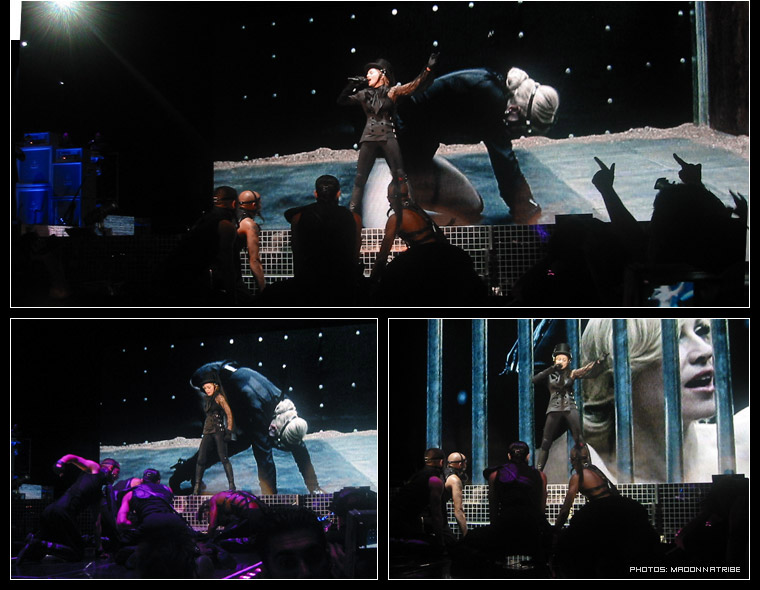 |
| |
MTribe: Brian, part of your work is also
being a link between the creative team and your clients.
Was working for Madonna different?
Brian: Not really. The basic client relationship
was the same as for any job at STEELE. My job is to interpret
what the artist and director want and pass that along to
our team of artists to make sure it happens. Along the way,
Jerry and Monique and I make our own creative judgment calls,
as a team, on how certain things should be executed, and
hopefully our clients agree with our decisions. Typically,
they do, and that's why they hire us in the first place.
There's a lot of trust involved, which is based on our history
and experience. But ultimately, my job is foster that communication
on a daily basis to ensure everyone is happy, creatively.
|
|
 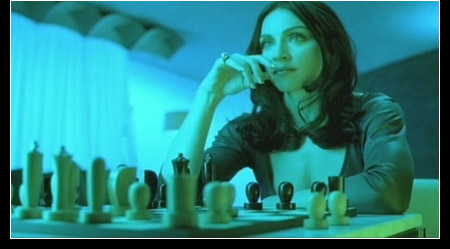 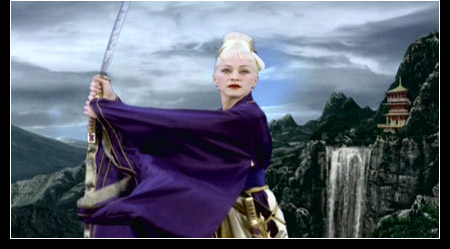
|
MTribe: Did you have
a chance to discuss your work on the video with Madonna?
Brian: We had an initial discussion
with all of the key creatives, and then a final consult,
but during the meat of our job, most of our communication
occurs with Clark Eddy, offline editor, and Hagai Shaham,
the production company's producer.
MTribe: In your
production reel you picked up images from two Madonna
videos dating a while back, "I'll Remember"
and "The Power of Good-bye".
What you did you do on those videos and were there other
videos featuring Madonna you had worked on?
Jerry: "I'll Remember" had
multiple projection screen fills and classic theatre atmospherics
(like smoke haze and the flickering light beams from a
projection booth) added. The theatre walls and ceiling
had digital enhancements.
A sound booth was completely created from scratch to accompany
a crane shot down to Madonna. All the movie inserts were
treated to appear to be within the theatre and all Madonna's
close ups and medium shots were individually treated for
facial beauty enhancements.
The second video, "The Power of Goodbye" had
much less set embellishments but had more beauty work
required.
At about the same time that we did "I'll Remember"
I also worked on a pair of commercials for a Japanese
sake featuring Madge as a mythical female samurai atop
a mountain controlling the weather and additionally defending
an glowing orb from a huge possessive golden dragon!
MTribe: Oh yes, the amazing Takara Jun
commercial!
MTribe: Even
if you are visual artist, music must have a great role
in your job. What about music in your everyday life?
Monique: Music
plays a huge role in my everyday life. I can't work without
it. It stimulates creativity and motivates me. Without
music the late nights would be unbearable.
MTribe: Can
you tell us something about working at STEELE. How is
your studio like, how many people are part of the team,
how's a typical day like?
|
|
| |
Monique:
Working at Steele is like being a part of a family.
We have an incredible group of artists. We all support and
complement each other.
Brian:
No day is the same here, depending on what we're
working on. We have an amazing core staff, which grows,
as the job requires. Our studio is broken into three main
creative areas: animation, which includes CGI, design, which
includes titles and graphics, and visual effects online
editorial/composite. The artists at STEELE are so talented,
and Jerry is an inspiration to all.
On any one day, we could be working on several commercials
and music videos at once and developing an in-house project
for R & D purposes.
|
|
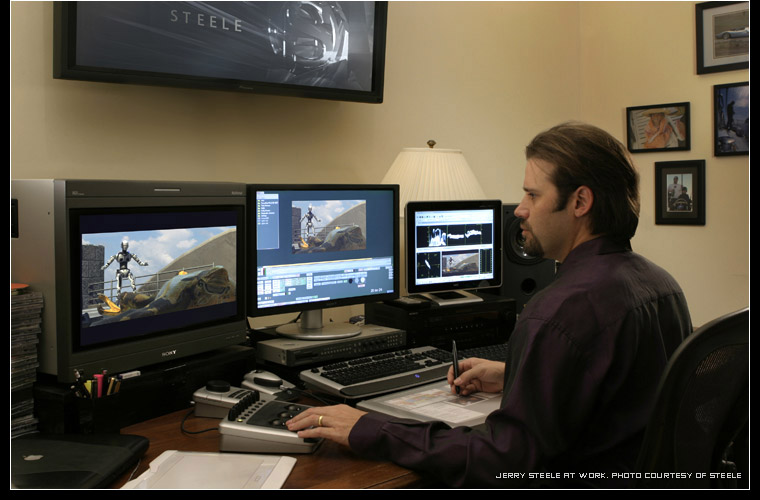 |
| |
MTribe: Back to
"Future Lovers", you were mentioning that you
had the chance to see the video during the live show.
It must be quite an experience to feel the crowd roaring
and cheering, responding to something you created, and of
course, you can tell how much the Madonna fans are loud!
Brian: Yes, as
I previously mentioned, seeing the opening show was a very
memorable experience. The best part for me was seeing how
much gratification our creative staff - especially Monique
- got from the audience reaction to their work. There's
nothing like the instant gratification of the live show,
and you can be sure the reaction is honest. There's no bullshit
from a packed arena.
|
|
|
MTribe: Was
there anything else that made your job on "Future
Lovers" something to remember?
Brian: This
is the probably the single most creative team, as a whole,
we've ever worked with. Starting with Madonna, of course,
the list goes on and on, but Jaime King as the show director,
Steven Klein director of "Future Lovers," which
was shot by Academy Award winning DP Janusz Kaminski,
edited by Clark Eddy, costumes by Gaultier…. We
are very proud to have been selected to work among such
creative industry leaders.
MTribe: It's
almost impossible to number the artists you worked for
and the projects you contributed to, but if you had to
pick one you cherish the most, what would he be?
Monique: Without
a doubt this was the most rewarding and challenging project
I have ever worked on.
Brian: I'd have
to agree.
Jerry: This was a highlight for our whole
company for sure.
Every job presents us with different pleasures, pains
and fulfillments, but we are the fortunate few who can
say that our occupation is our hobby and by definition
we offer our all to every project. Our passions reflect
in our work
and we leave each job thinking it was our best one yet.
MTribe: And
what's boiling in the cauldron at STEELE at the moment,
which is the most challenging upcoming projects you are
working on?
|
|
| |
Brian: We've been
working on an in-house sci-fi character animation piece
that we're very excited about. It showcases the full skill
set of our CGI division.
MTribe: It sounds
exciting!
Monique, Brian, Jerry, thank you so much for sharing your
time with our readers, we whish you all the best for your
upcoming projects and hope to see again the STEELE touch
on Madonna's future projects soon!
|
|
| |
Special thanks to Monique Eissing, Brian Adler and
Jerry Steele.
Be sure to check out www.steelevfx.com
to know more about the talents, the skills, the art, the
technology
and the people behind the amazing productions by STEELE.
|
|
| |
This interview © 2006 MadonnaTribe.
All pictures © 2006 MadonnaTribe except the STEELE
logo and where otherwise stated - All rights reserved.
|
|
|
|
|



